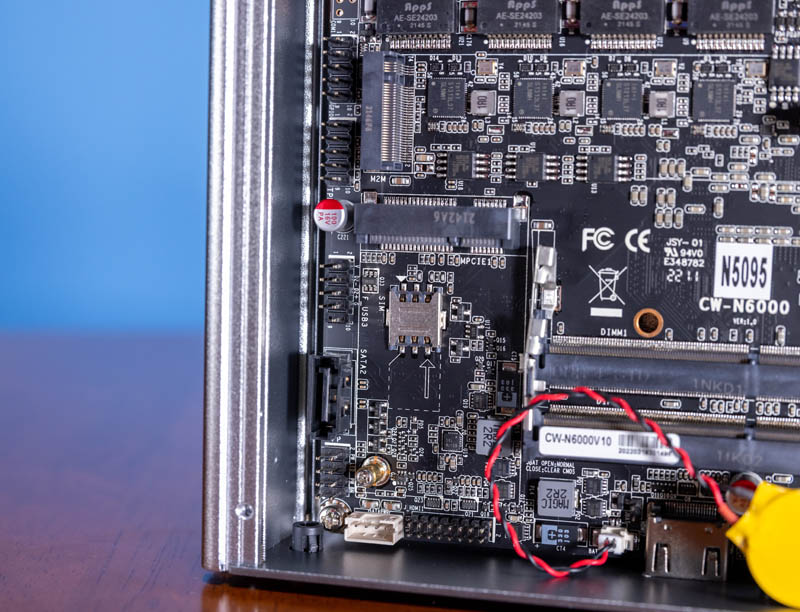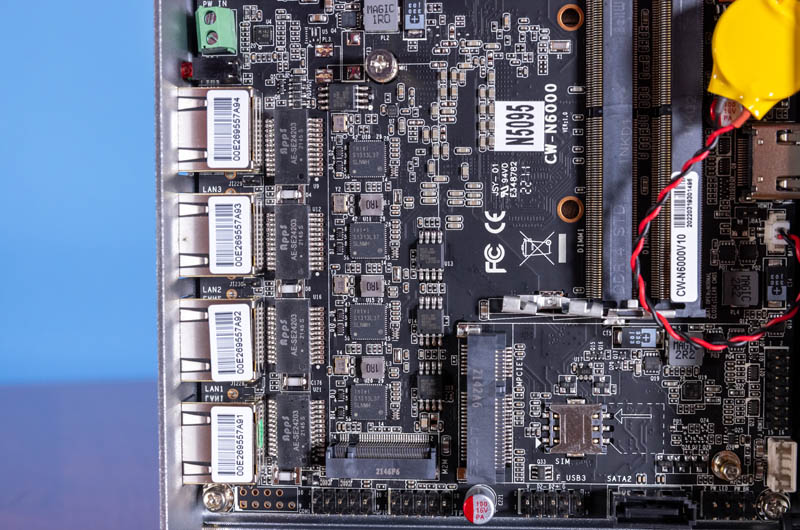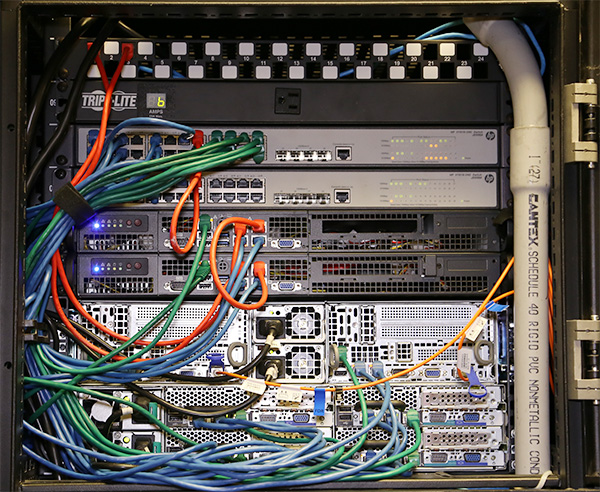Topton Intel N5095 4x 2.5GbE Firewall Review
The front of this unit has two USB 3.0 and a HDMI port. There is a power button that lights up and antenna holes. The chassis is mostly metal, but the faceplates were plastic. We will quickly note that with all of these units it has been common to get a different chassis than was pictured in the photos on AliExpress.

The other side of the unit is perhaps the more important end. It has 4x 2.5GbE ports. These are Intel i225 NICs and are the B3 stepping NICs.

There is also a DC 12V input. We have powered these via the PoE Made in China PoE Splitter we reviewed but the J4125 and N5105 are better options for that route given their lower power consumption.
Here is an internal view of the system. This is the same CW-N6000 motherboard we have seen in the N5105 and N6005 systems, just with the N5095 sticker.

Along the bottom here we get two SODIMM slots. Although we generally suggest using dual channel memory, many of the pre-configured systems come with only one DDR4 SODIMM. The benefit of having a single DIMM is lower power/ heat output.

Along the other side, we have a mPCIe slot with a SIM slot. There are apparently 3G/ 4G modems that can go in here, but we have not heard great things from users who have tried ordering them with the units. Feel free to comment if you have had a better experience.

Behind the RJ45 ports, we have the SLNMH Intel i225 NICs. That stepping is the B3 stepping. There is also a M.2 slot for a NVMe SSD. We suggest using a lower power option to keep power and heat generation down in these.

One other small feature is that there is a 4-pin fan header in the corner of the motherboard. Some users have either gotten units with bottoms that have fan holes or have made them via a Dremel or drill and used this. Since this is a fanless system with fairly sparse firmware, expect fan speeds to not be automatically controlled.

This is very similar to the other hardware we have seen in these units.
Next, let us get to the performance.




Living in Europe, I do appreciate your concern for the power consumption of the device!
However, I’m not sure your advice is sound.
Short variant: in an appliance context the max power consumption isn’t nearly as significant as the average power consumption for the job its doing–and that may be neglegable for those different bins.
Long variant:
All these Jasper Lake variants (perhaps even the dual cores) are most likely made from the same set of dice and just binned for outright defects, higher voltage requirements or even pure market segmentation.
In the case of voltage bins, that’s typically chips requiring higher voltages to overcome less than perfect transistores or interconnects, but it could also be chips that simply won’t run reliably at higher clocks.
In the first case an N5095 is liklely to consume more Watts than a N6005 at identical CPU core clocks. In the second case there might be no difference, though typically the two cases aren’t really isolated from one another.
These being 24×7 appliances, idle power consumption is really the bigger factor and the principal reason you should pay close attention to the power supply and it’s efficiency. Yet for the Jasper Lake SoCs, I’d expect very little difference. The difference in power consumption only really comes into play as these chips rev to near maximum clocks. And there somewhat like its Rocket Lake cousins, Jasper Lakes is happy to go into power consumption territory where no Atom has gone before: My J5005 based systems tend to stick pretty close to the 10Watt TDP mark they officially have, while my Jasper Lake N6005 NUC has been observed to really burn the 28Watt PL2 TDP the BIOS allocates by default.
Well, unlike my fully passive J5005 Mini-ITX systems (which never throttle!), it also has a fan…
But at least on the NUC BIOS you can tell it to keep it down and make do with 12 Watts PL2 and 10 Watts PL1, at which point it sure won’t be using more than a N5095, but it might not be much faster either (well Atoms are no speed daemons anyway).
Essentially with the N6005 you get a bit more choice and flexibility: you can let it rip near the maximum speed at the cost of the extra power or you can tone it down, if efficiency really were your top concern. You can’t change your mind with the 5095 and open up that throttle once you notice that that nice new broadband bandwidth update fails to make it through your firewall.
But even without restricting the BIOS TDP setting, chances are the practical difference in terms of power consumption between the top bin Jasper Lake and its lower variants won’t be noticeable, because if you operate them near those top clocks for extended periods of time, you’re most likely using the wrong platform: at 28 Watts a Core mobile part will give you more performance per Watt because that’s operating near its peak efficiency point there, than an Atom that’s left that point far behind and has little left to give except heat.
A couple of years ago I had to migrate from an J1900 Atom to a Kaby Lake i7-7700T Core CPU (35 Watt TDP) for my pfSense firewall , because with all the Suricata rulesets active, an Atom was quite overwhelmed and throttling the broadband bandwith, so be sure to measure realistically before you buy.
My only real comment is that the ranking on the first page is unclear, you put the N5095 at the top when in reality it was worst to best. So I started the article wondering why the ranking was backwards. Perhaps some refinement to qualify the order of the ranking could improve it a bit!
Hello everybody,
I want to give you my input on this, I bought this one, to use it as a router (VM in Proxmox, PCI passthrough), besides a router, I will host a Pihole, Home assistant, and an Unifi Controller, so 4 VM in total.
Also, I got a micro PC(Noname as this one) with just two NICs to do the same.
For the 4 ports I got branded memory and SSD, and for the 2 ports, I got it populated with Noname memory and SSD.
BOTH of them are not stable, the VM is crashing every few days, proxmox still works but the machines are crashing randomly, I disabled qemu guest agent and the crashes are happening half as much but still there, I have a lot of experience with proxmox with hundreds of VM hosted on it but I never saw this.
I will ditch them and return to Dell/Lenovo mini and micro PCs, even if they are a few generations behind. before those, I had a Dell 3020 that ran for more than two years without problems.
If you have thoughts please share them :)
Thanks for reading, I hope it helps.
I feel like I’m getting lost here.
I want to ditch my UniFi USG-3 in favor of going more opensource with PfSense.
I watched multiple of these fanless router videos so far and I still have no clue on what I should get.
4 ports should be fine, or maybe even 2 port, for WAN and LAN as I can do VLANing on my switches. Or is there a benefit in having a dedicated LAN port for each VLAN?
But I’m mainly getting lost at the CPU selection.
Should I go for N6005, N5105, i7-1165G7, or one of the i3/i5 options?
The system would probably run PfSense directly, maybe via Proxmox so I can save a back-up on my NAS. Some IDS/IPS would be nice, as well as VPN. PiHole already runs on my fanless Docker box (N5095).
I installed a protectelli (not sure of spelling) pfSense for my brother. Mostly game traffic (3 consoles, 720p streaming to multiple devices, then phones, and pc’s etc). Pretty sure we did the 4 port intel atom or something like that (not high end is the point). It does a great job and there are no regrets other than should have bought one for me too. It’s nice to have 4 ports.
Good article, it certainly doesn’t make any sense to upgrade these kind of PC’s with a Celeron.
I personally bought a Geekom Mini Air 11 with the N5095 and the only thing I did was upgrade RAM to 16Gb by adding a 8Gb stick to get dual channel. I really don’t think it actually had much affect. I also think Windows 11 runs fine up to a point, but I think a more efficient Linux distro probably works better for these tiny PC’s. I do think you get some advantage with 4 cores now rather then the Celeron’s with only two.